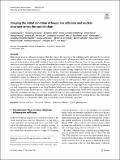Imaging the initial condition of heavy-ion collisions and nuclear structure across the nuclide chart
Author(s)
Jia, Jiangyong; Giacalone, Giuliano; Bally, Benjamin; Brandenburg, James D.; Heinz, Ulrich; Huang, Shengli; Lee, Dean; Lee, Yen-Jie; Loizides, Constantin; Li, Wei; Luzum, Matthew; Nijs, Govert; Noronha-Hostler, Jacquelyn; Ploskon, Mateusz; van der Schee, Wilke; Schenke, Bjoern; ... Show more Show less
Download41365_2024_Article_1589.pdf (2.515Mb)
Publisher with Creative Commons License
Publisher with Creative Commons License
Creative Commons Attribution
Terms of use
Metadata
Show full item recordAbstract
High-energy nuclear collisions encompass three key stages: the structure of the colliding nuclei, informed by low-energy nuclear physics, the initial condition, leading to the formation of quark–gluon plasma (QGP), and the hydrodynamic expansion and hadronization of the QGP, leading to final-state hadron distributions that are observed experimentally. Recent advances in both experimental and theoretical methods have ushered in a precision era of heavy-ion collisions, enabling an increasingly accurate understanding of these stages. However, most approaches involve simultaneously determining both QGP properties and initial conditions from a single collision system, creating complexity due to the coupled contributions of these stages to the final-state observables. To avoid this, we propose leveraging established knowledge of low-energy nuclear structures and hydrodynamic observables to independently constrain the QGP’s initial condition. By conducting comparative studies of collisions involving isobar-like nuclei—species with similar mass numbers but different ground-state geometries—we can disentangle the initial condition’s impacts from the QGP properties. This approach not only refines our understanding of the initial stages of the collisions but also turns high-energy nuclear experiments into a precision tool for imaging nuclear structures, offering insights that complement traditional low-energy approaches. Opportunities for carrying out such comparative experiments at the Large Hadron Collider and other facilities could significantly advance both high-energy and low-energy nuclear physics. Additionally, this approach has implications for the future electron-ion collider. While the possibilities are extensive, we focus on selected proposals that could benefit both the high-energy and low-energy nuclear physics communities. Originally prepared as input for the long-range plan of U.S. nuclear physics, this white paper reflects the status as of September 2022, with a brief update on developments since then.
Date issued
2024-12-11Department
Massachusetts Institute of Technology. Department of PhysicsJournal
Nuclear Science and Techniques
Publisher
Springer Nature Singapore
Citation
Jia, J., Giacalone, G., Bally, B. et al. Imaging the initial condition of heavy-ion collisions and nuclear structure across the nuclide chart. NUCL SCI TECH 35, 220 (2024).
Version: Final published version